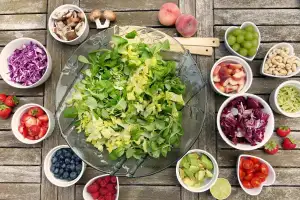Unlock the Sweetness: Easy Tips to Determine Pineapple Ripeness

When it comes to pineapples, ripeness is key. A perfectly ripe pineapple is a tropical delight, bursting with sweet and juicy flavors that can elevate any dish or simply be enjoyed on its own. However, determining the ideal level of ripeness can be a challenge for many. In this article, we will explore easy tips to help you unlock the sweetness of pineapples and ensure you enjoy them at their peak flavor. From visual clues to aroma and texture assessments, we will guide you through the process of selecting the perfect pineapple for your culinary adventures. So let's dive in and discover how to identify that golden fruit that promises a mouthwatering experience!
Visual Clues: Examining the Exterior
When it comes to determining the ripeness of a pineapple, one of the first things you should do is examine its exterior. Look for a pineapple that has a vibrant and golden color. Avoid pineapples that have any green patches as this indicates that they are not fully ripe yet.
In addition to color, pay attention to the texture of the skin. A ripe pineapple should have a slightly rough and bumpy texture. If the skin feels too smooth, it may be an indication that the pineapple is not yet fully matured.
Another visual clue to look out for is the size of the eyes on the pineapple's surface. Ripe pineapples tend to have evenly spaced and small eyes. If you notice large or unevenly spaced eyes, it could mean that the pineapple is overripe or starting to spoil.
Remember, appearance plays a significant role in determining ripeness, so take your time to carefully examine the exterior of each pineapple before making your selection.
Smell Test: Detecting Aromatic Sweetness
When it comes to determining the ripeness of a pineapple, your nose can be a powerful tool. The smell test is an easy and effective way to detect the aromatic sweetness that indicates a perfectly ripe pineapple.
To perform the smell test, simply bring the pineapple up to your nose and take a deep inhale. A ripe pineapple will emit a strong, sweet aroma that is hard to miss. If you can't detect any scent or if it smells sour or fermented, then the pineapple is likely not yet ripe.
The reason why smell is such an important indicator of ripeness in pineapples is because it is directly linked to the fruit's sugar content. As pineapples ripen, their sugar content increases, resulting in a more fragrant and sweet aroma.
So next time you're at the grocery store or farmers market, don't forget to give those pineapples a sniff before making your selection. By using your sense of smell, you'll be able to unlock the true sweetness and enjoy a perfectly ripe pineapple every time.
Firmness Check: Evaluating Texture
When it comes to determining the ripeness of a pineapple, evaluating its texture is crucial. A ripe pineapple should have a firm yet slightly yielding texture when gently pressed. Avoid pineapples that are too soft or mushy, as they may be overripe and have a less desirable taste and texture. On the other hand, if the pineapple feels too hard or unyielding, it may not be fully ripe and could lack sweetness. The perfect pineapple strikes a balance between firmness and tenderness, ensuring a delightful eating experience.
Leaf Color: Observing the Top
When it comes to determining the ripeness of a pineapple, don't forget to take a close look at the top. The color of the leaves can provide valuable clues about the fruit's readiness to be enjoyed.
A ripe pineapple will have vibrant green leaves at the top. If you notice any browning or yellowing of the leaves, it may be an indication that the fruit is overripe or past its prime. On the other hand, if the leaves are still mostly green with just a hint of yellow towards the base, you've likely found a pineapple that is perfectly ripe and ready to be savored.
Remember, while leaf color is a helpful indicator, it shouldn't be solely relied upon. It's best to use this observation in conjunction with other methods to ensure you select a pineapple that is at its peak sweetness and juiciness.
So next time you're at the grocery store or farmer's market, pay attention to the color of those pineapple leaves. It could make all the difference in unlocking that perfect burst of sweetness when you bite into your next tropical treat.
Weight Assessment: Gauging Juiciness
Another way to determine the ripeness of a pineapple is by assessing its weight. A ripe pineapple will feel heavy for its size, indicating that it is filled with sweet and juicy flesh. When you pick up a pineapple, compare its weight to other pineapples of similar size. If it feels lighter than expected, it may not be fully ripe and could lack the desired juiciness.
Remember that the weight alone is not enough to guarantee ripeness, but when combined with other methods such as visual clues and smell tests, it can provide valuable insights into the fruit's overall quality. So, next time you're at the grocery store or farmers' market, don't forget to give those pineapples a gentle lift to assess their juiciness potential.
Sound Check: Listening for a Hollow Thump
When it comes to determining the ripeness of a pineapple, one often overlooked method is the sound check. By tapping on the fruit, you can listen for a hollow thump that indicates it is ready to be enjoyed.
To perform this test, gently tap on the pineapple with your fingers or knuckles. A ripe pineapple will produce a deep, resonant sound, similar to tapping on a drum. If the sound is dull or flat, it may indicate that the pineapple is not yet fully ripe.
The reason behind this technique lies in the composition of the fruit. As a pineapple ripens, the cells break down and create empty spaces inside. When you tap on a ripe pineapple, these empty spaces allow for vibrations to travel through the fruit, resulting in a hollow thump.
However, it's important to note that this method should not be solely relied upon. It should be used in conjunction with other techniques mentioned earlier to ensure accuracy in determining ripeness.
By incorporating the sound check into your arsenal of pineapple ripeness tests, you'll have another tool at your disposal to unlock the sweetness and enjoy a perfectly ripe pineapple.
Unlocking the sweetness of a perfectly ripe pineapple is a true delight for any food lover. By following these easy tips to determine pineapple ripeness, you can ensure that every bite is bursting with flavor. Remember to examine the exterior for visual clues, detect aromatic sweetness through the smell test, evaluate texture with a firmness check, observe leaf color at the top, gauge juiciness by assessing weight, and listen for a hollow thump during the sound check. With these techniques in your culinary arsenal, you'll never have to settle for an underripe or overripe pineapple again. So go ahead and indulge in the joy of cooking with a perfectly ripe pineapple - it's like receiving a love letter from nature itself!
Published: 17. 11. 2023
Category: Food



